19 Jan 2025
First impressions of the Hasselblad 907x 100c
In the quest for the perfect camera, I was lucky enough to get the chance to try out a Hasselblad 907x 100c with a 38mm f2.5 V lens.
The reason is that I'm looking for a camera system that inspires me to shoot, which I feel a connection with.
I’m a hobbyist, not a professional, although I’ve been into photography since I was eleven years old. So I'm trying a Hassy to see if it's something I can get along with, and I thought I'd make a note of my first impressions for my own records and to help anyone out there considering one.
From the Epson R-D1 to Leica Q to Hasselblad
The camera that I had the best time with so far is the Epson R-D1. "WTF!", I hear you say. It's an old digital rangefinder on a Bessa body. I just loved shooting that thing, especially with the Zeiss Planar f2.0. There was something very special about the limitations of the camera, with it's lowly 6 megapixel sensor, wind-on lever to cock the shutter, manual focusing and limited ISO.
But I got pretty good with it and it became second nature.
Then kids happened.
It's pretty hard to shoot family life with a rangefinder. So, I eventually bought a used Leica Q to have some of that good old manual feel combined with autofocus and more point-and-shoot capability.
It took a while to get used to a 28mm lens, but the Q fit the bill really well.
Recently, the image quality has dropped due to dust, so it's off with Leica for repairs.
I'm now trying a Hasselblad 907x 100c in the hope to get some of the fun and connected shooting vibe, but with autofocus and better dynamic range.
Note that I tried a Q3 43 in Leica Switzerland, and that was awesome. But the 907x has been on my mind so I needed to try one to scratch the itch.
It's very early days with the Hassy, at the time of writing I’ve not even taken it out in daylight yet, so you're getting some raw first impressions from taking it out of the box and shooting cats.
I wanted to get it down whilst it was fresh in my mind, and I will hopefully cover some ground that other reviewers haven’t covered.
Retro, cool, solid
Opening the box, it's beautifully packaged and it struck me how beautiful, solid and old-school it is. What a cool bit of kit.
Setting up, it took me a while to get the sensor cover off, who knew you could slide the top button to the side to release it. I had to actually read the manual to figure it out. After that, setting up was easy. I attached the body to the digital back and then clipped on the lens - a 38mm f2.5 V.
Also a brick!
One thing that I hadn't seen in any of the reviews I’ve read is that it's a brick! It feels really heavy compared to my Leica Q. I had actually compared weights before deciding to try it, but just didn't realise how much that weight would feel in the hand.
The body is 620g compared the lighter Leica Q at 590g. But if you add 350g for the 35m f2.5 lens, that takes the total Hassy weight up to 970g, almost 1KG!
I don’t know if this is a problem yet, just an unexpected surprise given how so many say this is the “small and portable” medium format camera. It’s probably because I’m a noob that this shocked me!
Unusal to hold
The jury is out about the handling of this. It’s very cool but also very different. I love the waist level shooting and looking down at the LCD. I don’t feel I’m missing a electronic viewfinder on this becuase it wouldn’t make sense.
What’s a bit tricky is the secondary button. Basically it works like this if you’re shooting in manual (which I’m drawn to in lower light to keep the shutter speed above 100 to avoid shake):
- Use the front shutter button to capture an image
- To set aperture, rotate the front dial. Or, use the ring on the lens.
- To set shutter speed, hold down the secondary button on the right side of the camera whilst rotating the front dial.
- To set ISO, use the menu on the LCD.
The tricky bit is using holding in the secondary button whilst using the front rotary control. You have to hold it in a way where you’re cradling the camera in your right hand so you’re thumb can always get to the secondary button, whilst your finger hovers over the shutter button and rotatary control.
This is probably only an issue in low light where you want control of the ISO, shutter speed and Aperture. I’ll deliberately under expose to get a bit more shutter speed. But I don’t want the ISO much above 800 or 1200 to retain the image quality.
Easy to navigate around the menus
On first impressions, the menu system is really slick. It’s a doddle and didn’t take any time to get use to. You can achieve most functions in just a few taps, such as switching on face detect, adding a self timer, setting focus bracketing etc.
And all these functions are really nicely thought out and work great. For example, when setting up focus bracketting you can opt for it to exist that mode after you take a shot, or stay in it for subsequent shots.
As most reviewers say, the touch screen feels as responsive as my iPhone 16 Pro. It’s also beautifully designed from a UX perspective.
Very hard to use in low light
In a world of iPhones, Sony’s and Leica Q’s, we’re used to pointing and shooting. And, these cameras are great in low light, you barely have to think. But with the 907x, it's a different story.
I received this camera in the evening, so my first hours with it have been in low light. My initial thinking is - this camera doesn’t love low light. And although I’d read this before, it’s hard to appreciate the challenges until you face them first hand.
In a nutshell, in Aperture Priority the camera will often drop your shutter speed to 1/30 or lower, which is very hard to get a sharp image with when hand-held without IBIS. When shooting cats and kids in low light, I need a minimum of 1/125 to get a rushed quick snap. In fact, 1/200 is ideal.
It's worth noting that the X2D is a different story with it's effective 8 stops through in-camera IBIS.
But moving on... Let’s just say I’m still figuring it all out and I'm hopeful I can find a way of working that gives me good low-light results. I used to take the Epson R-D1 out with me on nights out in Leeds, and always got cool low-light shots despite it's flaws. The Epson wouldn’t work above ISO 1600, had no IBIS, and manual focus only. Yet, I still got some awesome shots, often after a ton of beer too.
The 907x has fewer constraints than the Epson, so I’m pretty determined to make it work. I’ll update this post once I’ve played around more.
Oh, despite the doom and gloom on this, I was able to get a photo of my cat in low light by underexposing and setting shutter at 120 and then recover, crop and it came out amazing.
Pro’s and Con’s
Pros
- It’s the coolest looking camera in the world
- Feels totally solid
- Colours are really natural and balanced
- Raw’s are very flexible, you can polish a turd nicely
- Very easy to use through the menus
- Touch to focus on LCD
- Manual focus clutch on the V lenses
Cons
- A bit of a heavy brick compared to the Q
- Still getting used to using the secondary button with front rotary control
- Hard/impossible to make work in low-light or even mildly low-light
- No way to set minimum shutter speed in Aperture priority mode, meaning you can find yourself trying to shoot at 1/30 and getting no results.
- This is amplifed by the 100mp sensor, where the slightest movement causes a blur that wouldn’t be noticeable on, say, a 20mp sensor.
- The lack of IBIS makes this worse (although I’m used to that on the Epson).
Watch this space
I’ve not even taken this thing out in daylight yet, so I’ll post some pics and more thoughts once I’ve used it a bit more.
As a hobbyist singer-songwriter, I've spent three decades exploring the art of recording acoustic tracks. After analysing insights from over 40 experienced recordists in the Massdog Music Home Studio community (370,000+ members), I've discovered patterns in what really works - and what doesn't.
Let's explore the most proven approaches, ranked by their effectiveness based on community validation and real-world success.
1. The Guide Track Method (Most Endorsed)
Endorsed by 9 community members, including several top contributors
This emerged as the most validated approach across all skill levels. For a clear demonstration of this technique in action, check out Alex Biggs' comprehensive tutorial, which walks through the entire process step by step.
"I always start with a guide track, which never appears on the actual release, of me singing along to my acoustic guitar. I then record the guitar part by playing along to the guide, then add the vocal." - Phil Matthews
The method's strength lies in combining the best of both worlds: capturing your natural performance energy while maintaining clean, separate tracks for mixing. Multiple producers specifically noted how this approach preserves the emotional authenticity of the performance while allowing professional-quality mixing.
Key Steps:
- Record a complete performance with both guitar and vocals
- Use this as your reference track
- Record guitar separately while listening to the guide
- Record vocals as the final layer
- Remove the guide track
2. The Track-by-Track Recording Approach
Validated by 6 community experts
This traditional studio method remains popular for good reason. Before diving in, watch Miguel Weissman's insightful video on avoiding common overthinking pitfalls with this method.
"Record guitar first and then do the vocals so you have control over the vocals and instrument. That's how professional studios do it." - Nick Boyd
Key Steps:
- Set up microphone(s) for guitar recording
- Record the guitar part, focusing on a clean performance
- Re-position microphone(s) for vocal recording
- Record vocals while listening to the guitar track
- Review and potentially re-record any sections that need work
However, an important caveat emerged from the discussion: while this method offers maximum control, it may not suit everyone. As Michael Harvey notes, "some artists deliver their best performances all at once" - which leads us to our next approach.
3. The Performance-First Method
Supported by 5 community experts
This approach prioritises capturing the magic of a live performance. For a masterclass in this technique, watch Gillian Welch and David Rawlings' World Cafe performance, recorded with a single AKG 414 in figure-8 pattern - a perfect example of how simplicity can yield stunning results.
"The best way is whatever gets the best performance from the artist. Never allow technical/engineering issues to dictate what should be done." - Mark Gifford
For performers who thrive on the interplay between their voice and guitar, this method often produces the most authentic results.
Key Steps:
- Find a comfortable performance position
- Practice the song several times before recording
- Focus on delivering a complete, emotionally authentic take
- Accept that some minor imperfections may be worth keeping
- Record multiple complete takes rather than trying to piece together perfect sections
It can be implemented in two ways:
3a. Capture two performers with a single mic in Figure-8
Perfect for those with minimal equipment:
"It only took 2 minutes to find the sweet spot, nice vocal with just the right amount of guitar. Both sounded great and the client was thrilled." - Cousin Steve
Key Steps:
- Choose a large-diaphragm condenser microphone if available
- Start with mic positioned at the same height as your mouth, about 2 feet away
- Point the mic where your voice and guitar naturally meet
- Do test recordings and adjust position until balance is right
- Mark the floor position and mic height when you find the sweet spot
3b. Capture guitar and vocals with a stereo ribbon mic
For those with more advanced equipment, this technique is beautifully demonstrated in Gordon Davies' cover of "Bittersweet Symphony", which uses a stereo ribbon mic in Blumlein configuration:
"Place the mic(s) with the capsules at 90 degrees to each other (One capsule pointing at your mouth, the other at the guitar) the null points of each will give you the max amount of separation." - Gordon Davies
4. The Room-First Approach
A fundamental principle endorsed across methods
Before considering complex mic techniques, multiple experts emphasized the importance of your recording space:
"The magic of Sun Studio is the mostly untreated room they record in." - Carl Smith
Key Steps:
- Test different spots in your room by playing and singing
- Listen for unwanted reflections or resonances
- Try corners first (they often sound better for acoustic instruments)
- Consider basic acoustic treatment if needed (blankets, cushions, etc.)
- Once you find the best spot, mark it for consistency
This foundation often matters more than expensive equipment.
5. The Vocal Mic + Acoustic Mic + DI Approach
Combining pickup and microphone signals
This method leverages both the acoustic guitar's built-in pickup system and traditional microphones for a fuller sound:
"I DI the guitar and mic the vocal with a Beta57 on separate tracks as a guide. Build the band on top of that. Then go back and mic the acoustic with a mic to suit its tone." - Brendan Read-Jones
For an excellent example of sophisticated multi-source recording, listen to Manchester Orchestra's acoustic version of "I Know How To Speak". They used an SM7B for vocals (about 3" away) and two large-diaphragm condensers on the guitar, demonstrating how multiple sources can create a rich, full sound while maintaining clarity.
Key Advantages:
- Blend of direct and acoustic sound
- Backup options if one source has issues
- More control during mixing
- Can emphasise either natural or processed tone
Key Steps:
- Connect acoustic guitar's pickup to audio interface through a DI box
- Set up microphone(s) for the guitar
- Check phase relationship between pickup and mic signals
- Record both sources to separate tracks
- During mixing, experiment with balance between DI and mic signals
- Consider using different mic positions to complement pickup sound
6. The Vocal Mic + Electric Guitar DI Method
Clean, consistent signal path
Using an electric-acoustic guitar with DI offers unique advantages, as noted by Per Sahlström who "uses DI from an electric guitar with a stage condenser for vocals, noting minimal bleed issues." For a practical example of this approach, check out Cheap Motel by Andrew Wall, which demonstrates the clean, professional sound achievable with this method.
Key Advantages:
- Zero bleed from vocals
- Consistent sound regardless of room
- Perfect for layering with other instruments
- Ideal for less-than-perfect recording spaces
Key Steps:
- Connect guitar directly to audio interface or through DI box
- Set input gain for peaks around -12dB
- Record a test to check for any buzz or interference
- Add subtle EQ and compression during recording if needed
- Consider double-tracking for fuller sound
- Pan double-tracked parts slightly left and right
7. The Vocal Mic + Acoustic Pickup Method
Combining traditional and contemporary approaches
This approach integrates multiple recording techniques for maximum flexibility, as beautifully demonstrated in the Party of Two (One Last Wish) recording shared by Wade Jackson, which combines a large diaphragm condenser and piezo pickup for a rich, full sound.
"My choice of vocal mic is the EV re-20 used very close which gives remarkable isolation without all the proximity effect." - Bryce Chicoine
Key Steps:
- Set up both close and room mics for the guitar
- Add DI if available
- Position vocal mic with attention to rejection patterns
- Record all sources simultaneously
- Keep all recordings, even if you don't plan to use them all
- Blend during mixing to taste
Practical Recommendations
Before diving into any of these methods, watch Electrical Audio's How-To: Recording Acoustic Stringed Instruments shared by Nivek Ekzem, which provides excellent foundational knowledge for all these approaches.
Based on your setup:
If you have one microphone:
- Start with the Single Mic Setup
- Focus on room placement and mic position
- Consider the Guide Track Method for more control
If you have two or more microphones:
- Try the Figure-8 Pattern Method
- Experiment with the Modern Hybrid approach
- Still consider using the Guide Track Method for complex arrangements
If you're building larger arrangements:
- Definitely use the Guide Track Method
- Consider adding a click track if needed
- Remember you can always simplify it later
Equipment Guide: What The Pros Use
In this section, we'll examine specific gear choices, illustrated by real-world examples from our contributors' recordings. For instance, the Manchester Orchestra acoustic session demonstrates the effectiveness of combining an SM7B for vocals with carefully placed large-diaphragm condensers for guitar.
Microphones
The most frequently mentioned microphones include:
For All-in-One Recording:
- AKG 414: A versatile workhorse, especially good in figure-8 pattern for isolation (as demonstrated in the Gillian Welch recording)
- AT-4033: Praised for its ability to capture both guitar and vocals naturally
- Neumann U87: The gold standard for both vocal and room recording
For Vocals Specifically:
- Shure SM7B: Favored for its excellent isolation properties, as demonstrated in the Manchester Orchestra recording
- EV RE-20: Praised for close-mic vocal recording with minimal proximity effect
- Sennheiser MD431: Recommended for its good off-axis rejection
For Guitar Recording:
- DPA 4099: Excellent for close-miking acoustics
- Royer SF12: Stereo ribbon mic, perfect for Blumlein technique (as heard in Gordon Davies' recording)
- AT825: Great for capturing room sound
Guitar Equipment
Pickup Systems:
- Baggs saddle transducer: Mentioned by several pros for clean DI recording
- Bill Lawrence pickup: Used successfully in hybrid setups
- Internal piezo systems: Popular when blending with microphone signals
Direct Input Equipment:
- Neve DI box: Favored for its clean, professional sound
- Sound Devices MixPre3: Mentioned for portable recording setups
Notable Microphone Techniques
Throughout our community examples, several microphone techniques stood out:
- Figure-8 Pattern Usage
- Demonstrated excellently in the Gillian Welch recording
- Maximises separation between guitar and vocals
- Particularly effective with AKG 414s
- Blumlein Pair Setup
- Two figure-8 mics at 90° angles
- Creates natural stereo image
- Example: Gordon Davies' "Bittersweet Symphony" cover
- XY Pairs for Guitar
- Provides excellent mono compatibility
- Popular with small-diaphragm condensers
- Great for capturing full range of acoustic guitar
- Mid-Side Recording
- Offers flexibility in stereo width
- Maintains perfect mono compatibility
- Particularly useful when recording in smaller rooms
Additional Resources
Our community members have shared several excellent resources that provide deeper insights into these recording techniques. Here's a curated collection of the most valuable demonstrations and tutorials:
Tutorials and Demonstrations
- Recording Acoustic Guitar And Vocals At The Same Time - Alex Biggs' detailed tutorial walks through various recording techniques
- How OVERTHINKING Can RUIN Your Song Recordings! - Miguel Weissman's important perspective on keeping things simple
- Electrical Audio How-To: Recording Acoustic Stringed Instruments - Comprehensive guide to microphone techniques
- Recording A Singing Guitarist - A comprehensive written guide shared by Matt Houghton
Professional Examples
- Gillian Welch and David Rawlings on World Cafe - A masterclass in single-mic recording technique
- Manchester Orchestra - "I Know How To Speak (Acoustic Version)" - Example of professional multi-mic technique
- Bittersweet Symphony Cover - Gordon Davies demonstrates the Blumlein technique
- Party of Two (One Last Wish) - Wade Jackson shows hybrid mic/DI approach
- Cheap Motel - Andrew Wall demonstrates DI recording technique
Microphone Setup Analysis for Guitar and Vocal Recording
Single Microphone Setups
Large-diaphragm condenser (AT-4033)
- Technique: Single mic positioned at sweet spot between guitar and vocals. Focus on finding perfect placement for natural balance.
- Example: Cousin Steve's radio show recording - Simple one-mic setup that went straight to broadcast
AKG 414 (figure-8 pattern)
- Technique: Single figure-8 mic capturing both instruments using phase relationship
- Example: Gillian Welch and David Rawlings World Cafe performance
Two Microphone Setups
Large-diaphragm condenser for guitar, Stage condenser for vocals
- Technique: DI from electric guitar with stage condenser for vocals to minimize bleed
- Example: Per Sahlström's method - Focuses on clean separation with minimal bleed
Two figure-8 pattern condensers
- Technique: Uses null spots of figure-8 pattern mics for separation. One mic toward guitar with null at vocal position, other vice versa.
- Example: Charles Meserole's technique - Particularly effective for mid-side in small rooms
C414XLII (cardioid) + AT825 stereo
- Technique: Room-based setup with close mic 2ft from mouth, stereo mic pair 6.5ft away and 6ft high
- Example: Damian Panitz's method for natural room sound capture
Three Microphone Setups
Vocal mic, soundhole mic, pencil condenser
- Technique: Classic studio approach: One mic for vocals, one at guitar soundhole (panned left), one pencil condenser down neck (panned right)
- Example: Harry King's traditional studio method for maximum separation and control
Two hyper-cardioid mics + internal guitar mic
- Technique: Three-source recording with two external mics plus internal guitar mic. Manages leakage through careful placement.
- Example: Gherardo Infunti's triple-mic approach
SM7B for vocals, 2 LDCs on guitar
- Technique: SM7B close on vocals (3" away), two large diaphragm condensers on guitar neck (with/without capo)
- Example: Manchester Orchestra acoustic version
Four Microphone Setup
- EV RE-20 (vocals), 3 ADK mics (2 lollipop, 1 Munich seven) + Neve DI
- Technique: Complex multi-mic setup with close-miked vocals, multiple guitar perspectives, and DI blend
- Example: Joey Stuckey's EP recording setup
Key Insights
- Single-mic setups can be highly effective with proper placement and high-quality condensers
- Two-mic setups offer a good balance of separation and simplicity
- Figure-8 pattern microphones are particularly useful for their null point rejection
- More complex setups (3-4 mics) tend to be used in professional studio contexts
Notes on Implementation
- The success of any setup depends more on proper mic placement and room acoustics than the number of mics used
- Each additional microphone introduces potential phase issues that need to be managed
- More complex setups provide more mixing options but require more expertise to execute well
- The choice of setup should be influenced by the performer's comfort and ability to deliver their best performance
Final Thoughts
The data shows that while equipment quality matters, technique and comfort matter more. The most endorsed methods all prioritize capturing authentic performances over technical perfection. As demonstrated in the various examples above, from Gillian Welch's minimalist approach to Manchester Orchestra's multi-mic setup, there's no single "right way" to record acoustic guitar and vocals - the best method is the one that captures your performance most effectively.
Remember what Jelmer Knisper wisely noted: "Just take the guitar and your guts and play. This has nothing to do with recordings or advice from people who know how other people do it in a pro studio. This is you who wants to play. So, play."
In my never-ending quest to record acoustic guitar and sing at the same time, I've been looking at different ways to mic up the guitar. The problem I have is that my home studio is small and I can't really leave mic stands and cables everywhere, so I wanted something discrete yet very quick to pick up and play.
A few years ago, a bit of Googling revealed the DPA4099G - an condenser microphone that clips onto the guitar body. Despite that £400+ price tag, I decided to buy it. It's been "pretty good" and just lives on my guitar in the studio. I can pick it up and record immediately, which I love.
However, I've realised there are a few things that bugged me:
- It's a sensitive capacitor mic with cardioid a pattern, so it picks up quite a lot of vocal bleed
- My acoustic space is treated, but the dynamics fare better than condensers with my room and skills
- It's quite hard to point the mic away from your singing gob, whilst also being in the recording sweet spot where the neck joins the body
- The mic is a little close to the guitar. I'd usually have it 6"-12" away.
- I frequently knock the mic into a different position, or off the guitar altogether.
How to solve these problems?
- Well, I'm thinkng I might be better with a dynamic mic to record the guitar. But nobody seems to make something like the DPA 4099G but with a dynamic mic.
- A longer arm would also be useful, to get a little more distance and have more control over the sweet spot
So, I'm now on the hunt for alternatives. Since they're not easy to find at all, I've listed them here.
Exploraudio Liveguitar H-clamp
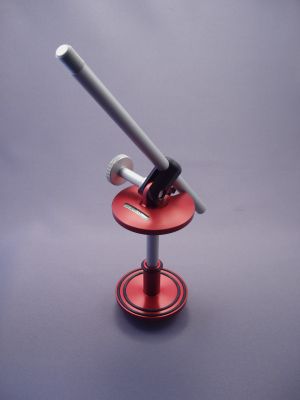
I really like the look of this one because it allow the mic to be further away, and it can hold an SM57 with excellent room rejection. It gets good reviews on SoundOnSound
More information here.
It's pretty easy to write unit tests for Flutter. The annoying thing is that there's no way to continuously run the tests each time you change a file. I find unit testing much better when tests run automatically as I code so I know when something is broken. I was hoping there would be a flutter test --watch but there isn't yet.
However, I worked out a hack that seems to work well.
brew install fswatch
fswatch -e ".*" -i "\\.dart$" . | xargs -n1 -I {} sh -c "echo $'\e[1;31m'{}$'\e[0m'; flutter test -j 2 ./test"
If you run this from the root of your application, you'll find that each time you tweak a .dart file, the tests all run again. There's probably a nice way to only run specific tests, but this will do me for now.
I'd also recommend you throw this in a file called watch_test.sh so all you need to do is type sh watch_test.sh. No need to remember the long command above.
If you find tests are too slow to watch continuously, consider fixing it. Tests should be fast.
- Tests that hit the network are slow, you could always add a skip flag to slow tests and test them individually later. Or even better, mock them out.
- Tests that hit the DB can be slow too, I'd recommend mocking that out too.
Enjoy
P.S - Credit to Warun K for inspiring this with his article here.
07 Apr 2020
Generating UML diagrams with curl and yUML
A lot of yUML users want to generate diagrams programatically. The best way to do this is by POSTing your DSL text to yUML. This overcomes the problem of too much text in your URL. Here's an example with curl:
curl -X POST -d "dsl_text=[Curl]->[Example]-.-[Nice{bg:wheat}]" https://yuml.me/diagram/scruffy/class/
This returns the filename with svg extension - e3c59524.svg
You can then download with whatever extension you like (svg, png, pdf, jpg, json) like this:
curl https://yuml.me/e3c59524.png --output test.png
And you'll get a diagram that looks like this:
A few tips
- For a non-scruffy diagram,
POSTto https://yuml.me/diagram/plain/class/ or https://yuml.me/diagram/nofunky/class/ - Your DSL should be comma separated, e.g.
[Curl]->[Example]-.-[Nice{bg:wheat}],[Curl]-[Stuff] - You can register with yUML to created named diagrams with permalinks. We haven't tested
POSTing diagrams in this way for that yet.
Enjoy!
22 Feb 2020
What I don't like about Scrum
Our wise previous Scrum Master, Dave Taylor, asked on LinkedIn:
Thoughts on teams/orgs that have already tried scrum but not found it useful. I’m always curious to understand which parts they didn’t like or find relevant to them - quite often we’ll discover that it’s things that are not actually Scrum anyway.
It's a great question. Dave taught me a lot about Scrum and was one of the few people I've met that seems to understand it. At least as far as I can tell, as I don't :)
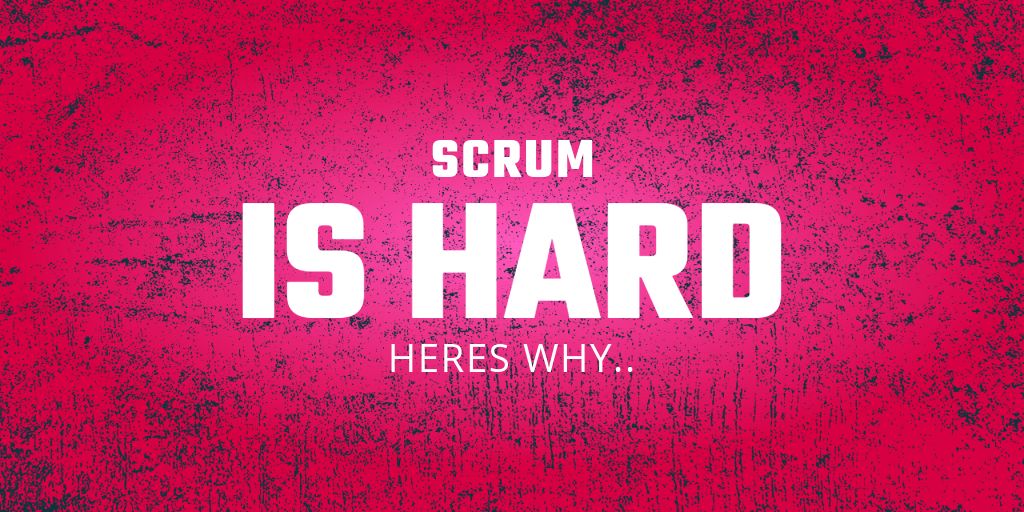
I personally think pretty much all of Scrum is useful. IMO, the one thing I really don't like about Scrum is that it's REALLY REALLY HARD to implement! And the Scrum Guide seems to only lay out a basic foundation, then you're on your own.
Here's the things I've personally found hard to achieve at Pocketworks. It's not that this stuff isn't useful, it's just that it's hard to implement.
DISCLAIMER: I'm not Scrum certified and might not understand some of this stuff!
So, what's so hard about Scrum?
Org Change
It often needs profound changes in attitude and business structure. Doing it properly probably means changing many aspects of your software business. That includes leadership, organisational structure, management styles, recruitment and promotions. This is a LOT to ask.
Cultural Change
To make it worse, if your company doesn't align with the scrum values, you're going to struggle. Cultural change isn't easy. Àgain, it's a lot to ask of a business.
Training
Because the concepts require quite a shift from traditional thinking, they're hard for people to accept, grasp and then live by. So training isn't easy. It requires a mind-shift. Training people on any kind of business process can be hard.
If you don't believe me, look at how many certified Scrum Masters are asked to perform project-management duties. Or look at how many Product Owners don't have the final say. Or how many Scrum development teams are downstream of separate UX/design teams. None of this would be happening if training Scrum was easy.
Cross-functional Teams
Scrum encourages forming teams that can create a shippable increment. This means having a mixture of designers, developers etc on the same team. Many companies find it easier to silo teams into different departments. So you have your iOS team, or your Design Team. These are then dependent on external teams to ship an increment. In some situations, this might mean org restructuring. Not for the faint hearted!
No Hand-overs
It feels logical to introduce things like "Design Sign Off" or "Peer Review". But Scrum encourages us remove stage gates in order to increase speed. That's counter-intuitive sometimes, you'd assume people with similar skills want to sit together. But instead, Scrum advocates usually encourage arranging people around the work.
No Team Heirarchy
Most companies want their Senior Developer, Lead UX or Architect roles. The idea that certain experienced people get the final say. Scrum doesn't recognise or encourage such heirarchy. But if you do that you're basically saying "This person has less autonomy and responsibility than the other". Scrum pushes for self-organising teams, which means they may elect to distribute such responsibilities amongst themselves, but not as mandated by the wider business.
Regular Stakeholder Feedback
Scrum advocates a series of feedback loops. One of these is that end-users and stakeholders should review the software every increment. Getting everyone in a room every few weeks is hard. Basically, people are busy, and they have to prioritise reiewing the software otherwise those reviews don't happen, which ultimatley means you're missing a key ingredient of Scrum.
And imagine this in a bank, where people are used to status reports and hands-off milestone tracking. None of that. If you want to see where stuff is at, go look at it.
Shippable Increments
Similarly, Scrum recommends that every week we have a potentially shippable increment of a product every Sprint. This is really hard because teams then have to take time to figure out how to slice the work up so that they can ship something in the sprint. It's easier just to crack on and hope for the best. So everyone has to appreciate the value of always-shippable.
Product Owner as Final Decision Maker
I've rarely heard about this being the case. The Product Owner is supposed to be a CEO of the product, managing profit and loss, budgets, performance, vision etc. But in reality PO's tend to end up being more like project managers where other teams or executives call the shots.
Terminology
People often Scrum requires things that it doesn't. None of these are part of Scrum...
- Story Points
- Stories
- Velocity
- Demos
- Refinement as-a Meeting (it's ongoing)
Story Points
"5 points is a day's work for our team". You hear this kind of crap all the time. Although points aren't even part of Scrum, it's so annoying how people still do this and associate it with Scrum. I spoke to a CEO last week who said "My team said they can do 1.5 points a day, and I told them they needed to buckle down and do 2 points a day". It's not his fault. It's just hard. I spent ten minutes trying to explain it and he still didn't get it. They're an awesome tool but few can get to grips with them and they end up being misused.
Thoughts welcome.
As a managing director, I hit problems in business on a weekly basis. Business just throws crap at you all the time. Then, you have to figure out what to do about it.
Here are a few examples of crap that hit me over that last 5 years:
- We’ve accidentally done £150,000 worth of work which we can’t invoice the client for because we didn’t have tell them we were doing it. Shit!
- We haven’t sold anything this quarter, how are we going to pay the bills?
- We’ve just gone over budget for the second time and the client is going to ditch us.
I used to just deal with problems like this in the moment. I’d figure out a solution and deal with it case-by-case. You can always find a way to get by, right?
The problem with this is that you don’t really fix anything. Problems happen again and again and again. And this means your business or department is going to be a pain in the backside to run. You’ll have less fun and more stress.
The good news is that, over time, I’ve learned a simple method for dealing with this kind of crap properly. A method that means it’s much less likely to happen again. So what is it?
“Make it visible.“
I could also have worded this as “Expose the data” or “Map it out” or “If you can’t see it, you can’t solve it”.
In my view, almost any recurring business problem can be improved by increasing your visibility of the problem. The idea is simple:
- Determine what data is relevant to the problem
- Capture the data, building a picture of the data in a way that gives you some insight
- Create a way of updating and reviewing this regularly
So, if you’re over-servicing a client, the solution might be:
- Record time spent on the client
- Create a report of time against budget
- Do this every week, and review
If there’s a problem, you can see it coming and deal with it before it escalates.
This is incredibly simple. Don’t let that put you off - it’s powerful too.
The trick is to approach problems thinking “What can we not see that allowed this to happen?”. You’ll soon realise that your business problems are often due to lack of visibility.
Your job is to create visibility.
Another upside is how you interpret what others say. So, when you’re in a meeting discussing a new load of crap that’s hit you out of nowhere, you’ll hear people propose solutions. Then, you’ll start categorising them in one of these two ways:
- Is it a solution that masks the root cause to get us through the day?
- Is it a solution that addresses the root cause so the problem is properly fixed?
You’ll start to favour solutions that consider the relevant information and which attack the root cause. And if the facts aren’t known, you’ll look for ways to reveal them so that your solution quality goes up.
Some of you might dismiss all this advice because you’re thinking “This is too obvious” or “I don’t have time or motivation for this”.
This is how I used to think too. And if you think like this, you have work to do. You need to have a hard think about why you don’t want to fix your own problems properly.
The thing is, how else can you do it? How do you expect to solve your business problems if you don’t a) look at them more closely and b) making that a repeatable thing?
Doing both of these things means you go from reactive to proactive. This is what allows the problem to stop happening.
Hope this helps!
P.S - If you're a software developer, this should work for you too. E.g. Tearing your hair out on a code base that's hard to change? You probably can't see the execution paths. What's the smartest way to make execution paths visible? Then you can look at simplifying them with refactoring. What can you do to make this complexity more visible on a regular basis?
I decided to invest some time improving my blog. It was feeling like an out-of-date, tired old place that gave me no inspiration to write. So, you’re now seeing the new, faster version that should work nicely on phones and tablets, and also be more readable with better structure.
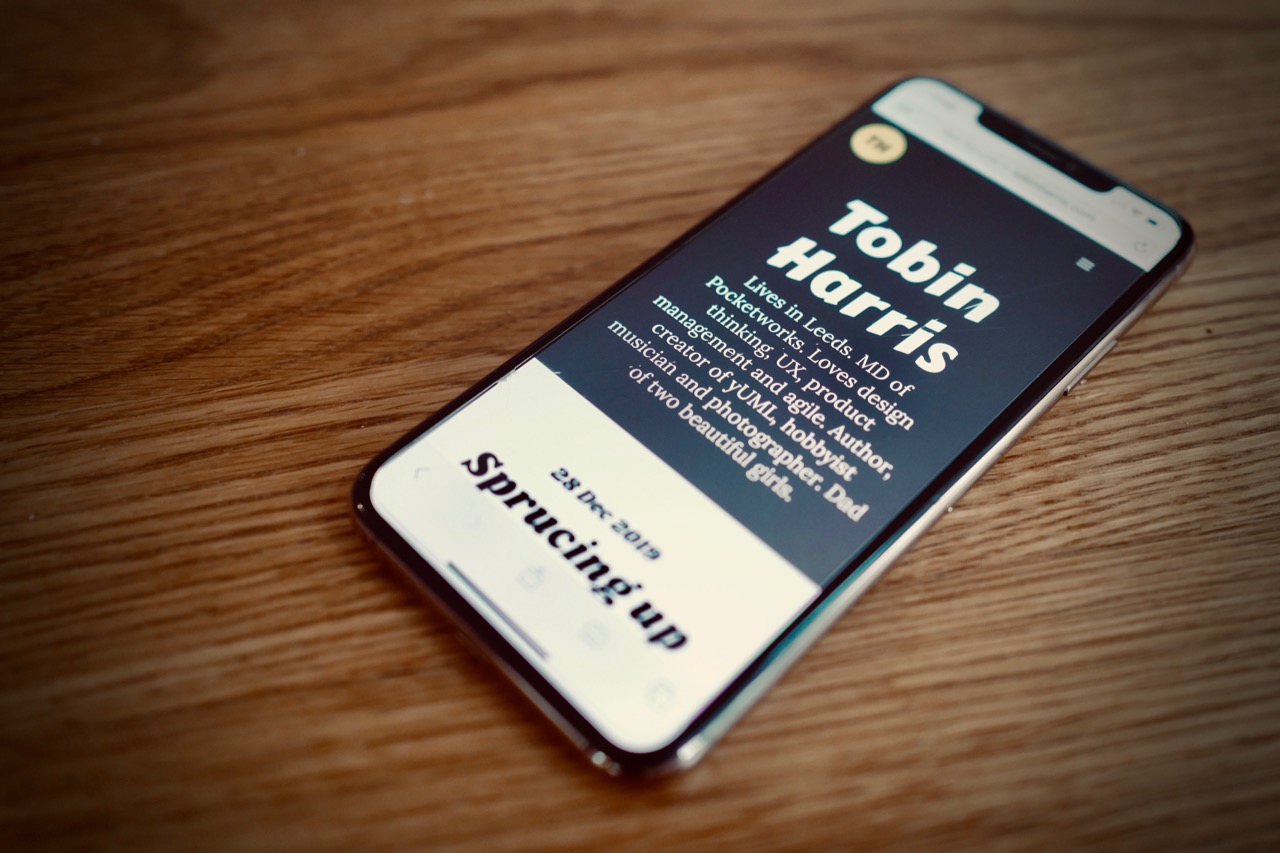 Renders nicely on the iPhone 11 Pro
Renders nicely on the iPhone 11 Pro
Here're the results from Google Page Speed.
 Speed test is reasonable :)
Speed test is reasonable :)
Why roll-your-own?
I considered writing on Medium before doing this update. But I don’t like the idea of someone else having control of my content. Or blocking people from reading it unless they pay. I enjoy Medium but hate the paywall.
Secondly, I’ve got lots of old posts on here. I thought about starting afresh but there’s something nice about keeping the history. That content still gets read today, so why throw it away?
I also considered the Ghost platform, which looks awesome. I decided against it once I’d reminded myself how easy Sinatra is to work with. Switching to Ghost would have meant having to import all my old content.
Bulma, Sinatra, Lazy Loading etc
Updating it wasn’t as bad as I’d feared. A re-skin and a few other improvements took only 4 hours.
This site was an incredible simple Sinatra site. The guts of the site are only 250 lines of code, and that includes post authoring CMS, tagging, archiving and RSS feed generation. The hardest part of working with it again was updating the dependencies, some which date back to 2008.
So, I decided to have a crack at modernising it, which basically meant updating to newer versions of Sinatra and Ruby, retiring the old CSS and trying out Bulma.io. I also applied some new typography, some lazy image loading and simplified the navigation. This meant it was mobile-friendly, faster to load and more readable.
I picked Bulma because I fancied trying something lighter than Bootstrap. Bulma seemed a little simpler. After 4 hours of use, I'm starting to get the hang of it. Instead of customising using it's npm package or webpack, I just monkey-patched the CSS. When I get more time I'd like to come back and customise it properly. Feels a bit hacky!
Cloudinary
If you look at old posts you'll notice lots of images are broken. I was using http://puush.me in the past, but for some reason, my images have gone. I considered a few new places to put the images.
- S3
- DropBox
- Cloudinary
Amazon S3 was my first thought for images. I could whack a CDN in front and all would be good. Unfortunately I couldn't find the login, and since everyone at work is on holiday couldn't easily find out.
Dropbox was the next stop. It seemed pretty good to start with. Just upload to a public folder, preview online, then copy the preview image URL. I then hit issues with .webp images on Safari (they don't work) and realised I needed to convert to .jpg.
Finally, I realised that something like Cloudinary would do this for me, and was actually designed for developer image hosting. So, I dragged the images up to there where there are a load of optimisation options available for a blog like this. I think the free account will do nicely for a while, so that's a bonus.
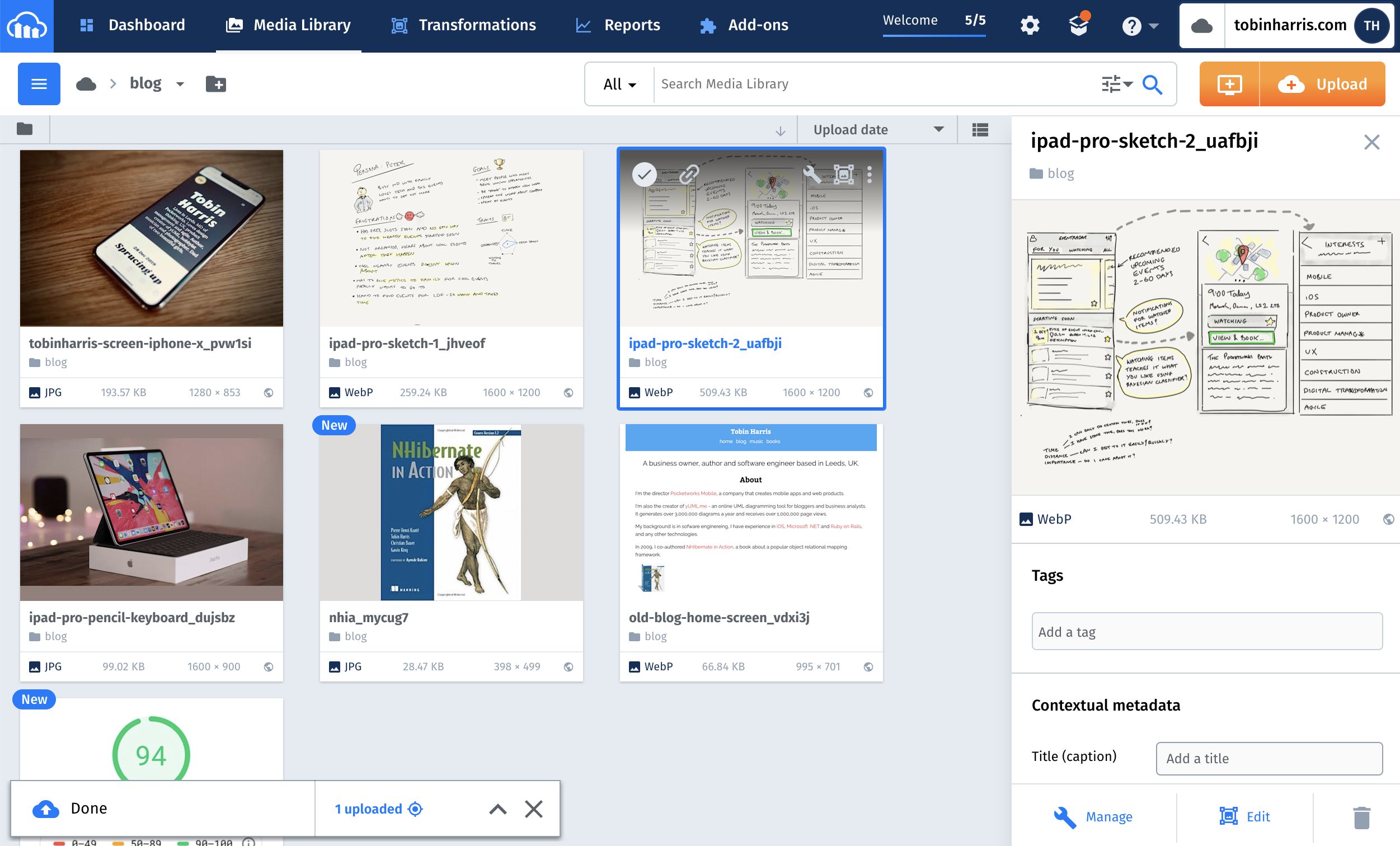 Cloudinary is really easy to use and has great features for blogs
Cloudinary is really easy to use and has great features for blogs
So, hope you enjoy the new blog. There are a few niggles to fix so I’ll get to those as I go.
Here’s the old site, in case you haven’t seen it. It’s also available on wayback machine.
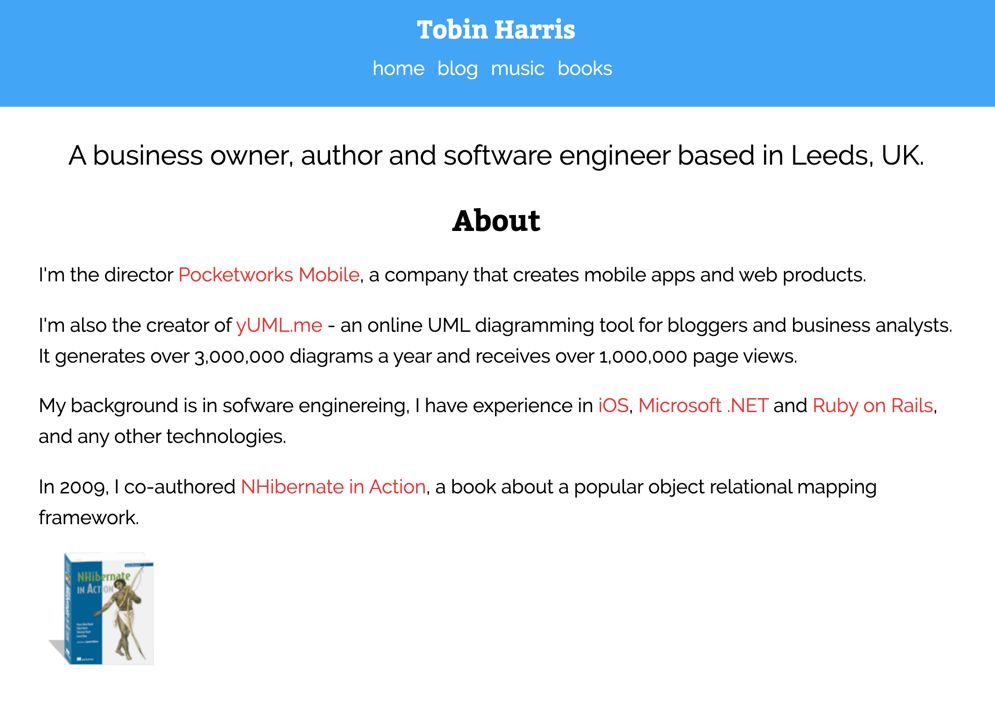 The old design of this site
The old design of this site
28 Dec 2019
Two months without the iPad Pro
I donated my iPad Pro to the office back in September. I had a 12.9-inch first-generation model from 2015.
A few months later and I am missing it badly. For one reason only - sketching.
I mostly used the iPad Pro for sketching notes, mind maps, user personas, user interfaces, that kind of thing. Here's some examples drawn with the 53 Paper app.
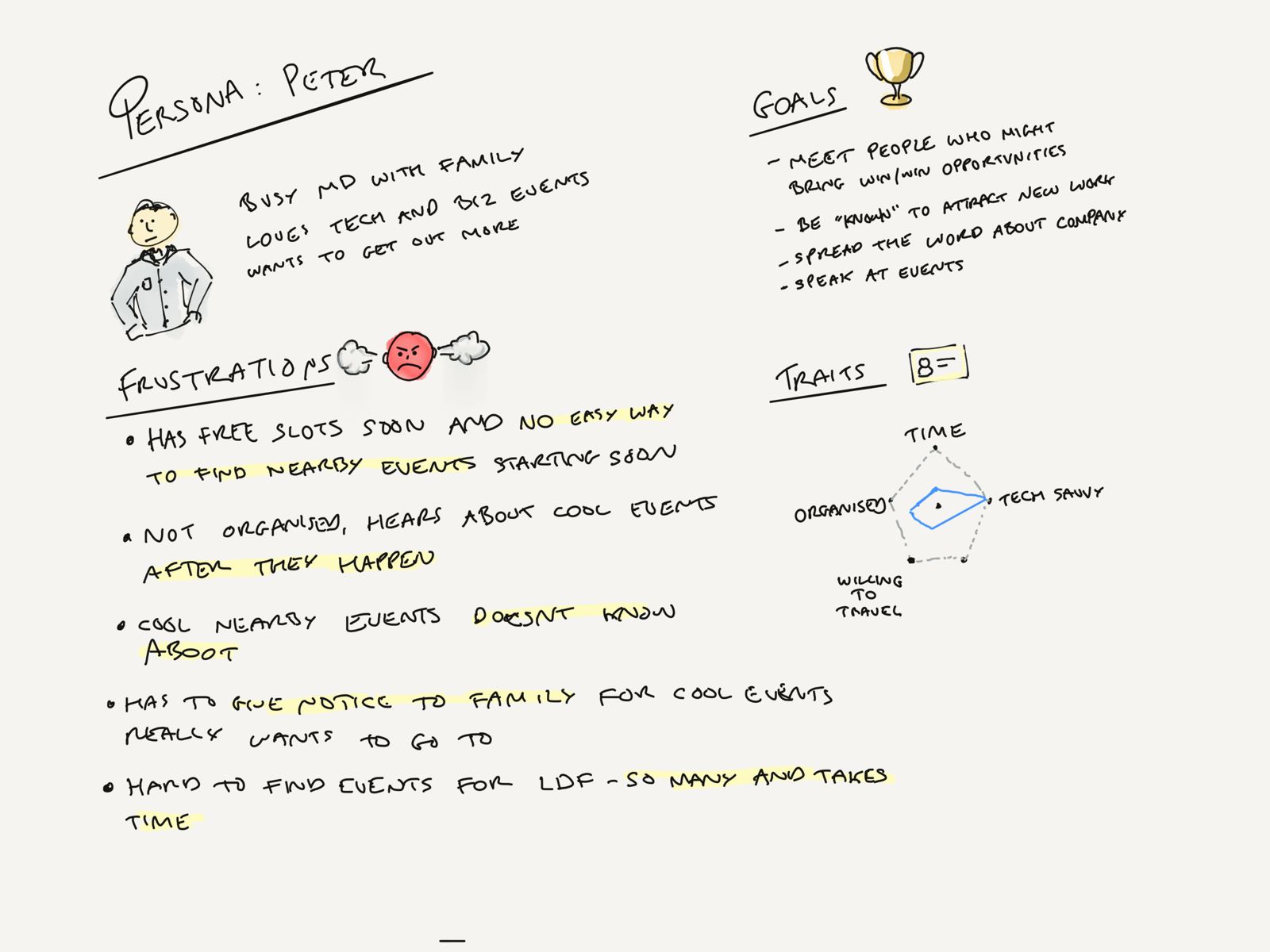 A user persona sketched with 53 Paper
A user persona sketched with 53 Paper
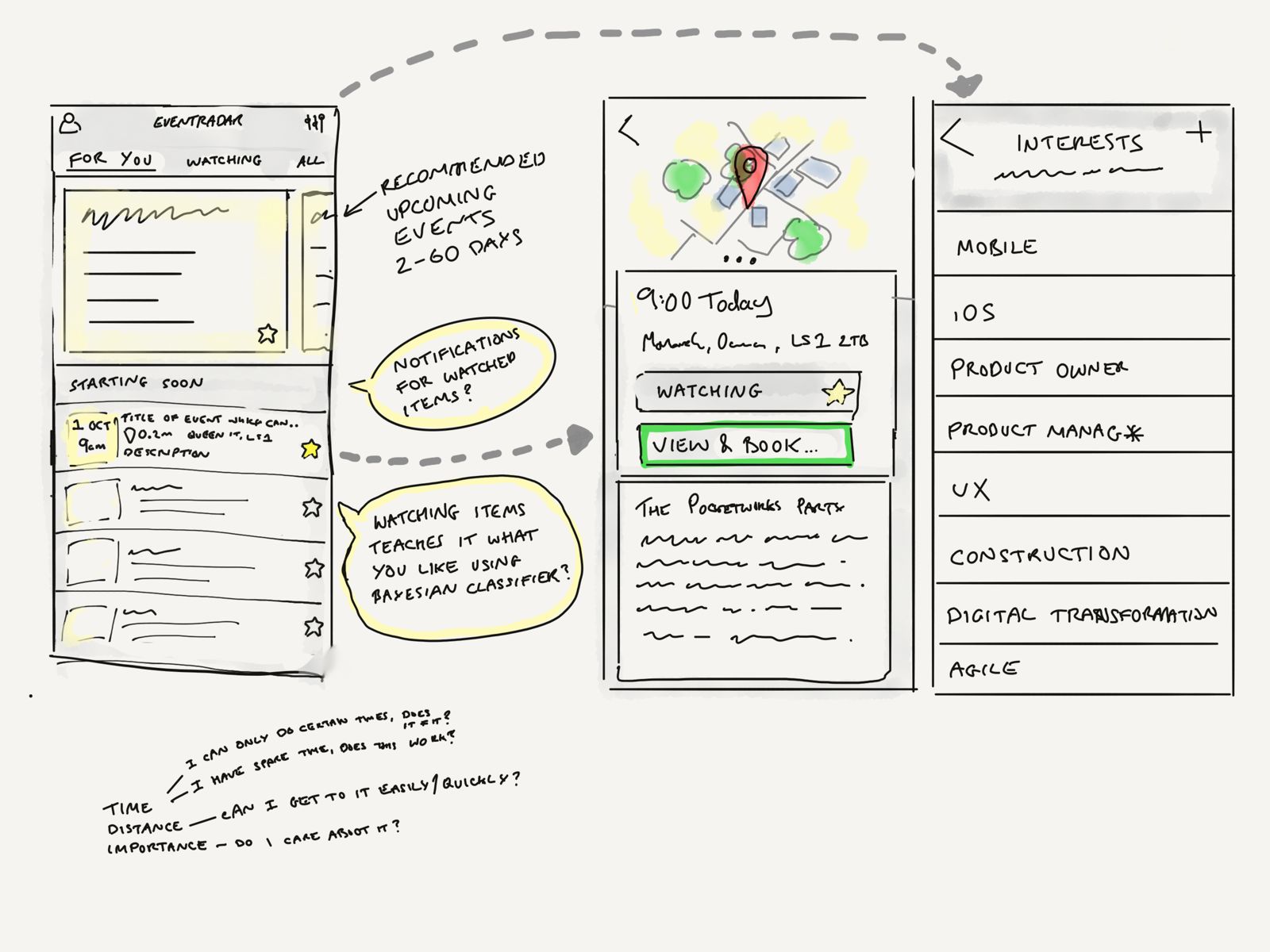 Some user flow ideas sketched with 53 Paper
Some user flow ideas sketched with 53 Paper
The problem was, the first-generation iPad Pro is a big beast. It's too big and heavy for everyday use in my opinion. So, for me, I'd only use it a few times a month. I'd use my smaller and lighter iPad Air for reading and daily around-the-house stuff.
I think a person only needs one iPad. Nobody wants to carry two iPads around with them. If you don't use the 2nd one very often, you forget to charge it, which means you can't use it when you want to. And then you have the hassle of running software updates twice.
If you're the sketching type, you should have one iPad that supports the Apple Pencil. Fortunately, in 2019 all iPads support the Apple Pencil. The iPad, iPad Air, iPad Mini and iPad Pro. The question is then, which pencil should you buy? First-generation or second-generation?
The newer Apple Pencil is better. It has an extra touch-sensitive sensor that you can tap to switch tools. It's also magnetic, so clips nicely to the side of the iPad when charging. Much better than the goofy Lighting connector setup seen on the first-generation Apple Pencil. If you're a serious sketcher who can afford £1,000, then the Pro is the sensible option because this is the only one that supports the new Pencil.
 The iPad Pro with Keyboard and Pencil will cost about £1,067
The iPad Pro with Keyboard and Pencil will cost about £1,067
In the near future, I'll be selling my old iPad Air and getting a new iPad Pro. Having not had one for a few months I really miss being able to visually throw ideas down. Having one iPad will simplify things a little. And I'll go for the smaller size so it's easier to carry around.
Think this is the right choice?
27 Dec 2019
Working long hours
There’s been some interesting debate on Twitter around working long hours. Jason Fried from Basecamp argue this:
If your company requires you to work nights and weekends, your company is broken. This is a managerial problem, not your problem. This is a process problem, not a personal problem. This is an ownership problem, not an individual problem.
I’m a big believer in standard working hours. So much that It's part of the business plan for Pocketworks in terms of our financial model and the culture we encourage. I chose this view after learning from a few sources:
- The agile community
- Personal productivity coaches
The agile community generally discourage mandatory overtime. Decades ago, Kent Beck came up with the notion of sustainable pace as part of Extreme Programming. This meant getting things done in the confines of a 30-40 hour working week. The idea is that teams learn to deliver software for the long-term without the team burning out or losing motivation.
This recognises that overtime is an anti-pattern because it can be used as a quick-fix for schedule, management or quality issues. If you hide the underlying issues, it’s very hard to fix them. In other words, you can’t fix what you can’t see.
Overtime also trips up your velocity. Velocity is a useful metric because teams can use it to forecast when things might be done. Ad-hoc over time will make it hard to achieve a stable velocity, which means you’re not going to be very predictable. Nor will you be able to be repeatable. Your performance each month will vary wildly.
Predictability and repeatability are good things to have in business.
Another angle is around personal growth. If you work late every day when will have time to develop your own skills by learning and practising?
Coaches such as Brian Tracey, Tim Ferris and Stephen Covey advise that we become disciplined enough not to take our work home with us. If you’re itching to do something productive instead of watching Netflix, use your own time for personal development and learning. In my view, it’s not “work” as long as it’s fun, entertaining and not stressful. For example, practising a new skill is generally fun, and you can break off to read a book or see friends whenever you want. That’s very different to work.
As someone who runs a business, I still work to this rule today. I use my free time to help my own development. Sometimes I practice techniques and ideas around real work, but most of the time I don’t want my personal experiments interfering with work deadlines and stresses because that can take the fun and motivation out of learning.
In short. If you’re a tech manager, give your business a chance at being sustainable by eliminating long hours or overtime. And when you do want to work out-of-hours, work on your own skills and education. Try not to mix this with your day job too much, otherwise, learning can become stressful.